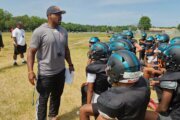While student growth has slowed in recent years, the U.S. is still a hotspot for international high schoolers.
The number of foreign students studying at U.S. high schools more than tripled from 2004 to 2016, according to a new report from the nonprofit Institute of International Education. More than 82,000 international students studied at U.S. high schools last year.
Foreign high schoolers mostly attend private institutions in the U.S., but some public schools are actively hosting these students.
Lake Shore High School in St. Clair Shores, Michigan, a suburban community outside of Detroit, hosts dozens of Chinese students each year, says Chris Hubbard, a history teacher at the school. The district even provides a dormitory for the tuition-paying students , who stay for one school year.
[Discover how foreign teens can attend U.S. high schools.]
American students benefit from working with international students, and the school benefits financially from the tuition these students pay, says Chelsie Crane, international student coordinator and English as a second language teacher at Dexter Regional High School in Maine, which recently started actively recruiting foreign students.
As more U.S. high schools embrace international students, some teachers may be unfamiliar with what educating these students entails. The following facts may help.
1. International students may be unfamiliar with American academic content and teaching methods. It’s been a challenge for international students to adjust from having a teacher lecture to them, to finding the information on their own and using the teacher as more of a guide, says Crane.
At her school, teachers focus on project-based learning and are trying to move away from being the focal point of the class.
Hubbard has found his Chinese students are not taught U.S. history in China and are not familiar with the basics of the subject, such as slavery in the U.S.
That creates a challenge, he says. He needs to teach the basics to catch up the Chinese students but doesn’t want to spend too much time doing so, as the American students may get bored and not pay attention, he says.
[Learn how high school exchanges offer early taste of international student life.]
2. American teens can benefit from their foreign peers. The community where Crane teaches is very rural, and many of the U.S. students are from low-income families — these students may never travel to another country, or even outside of Maine, she says.
“The benefit of being able to basically bring the world to them — instead of having them go out to the world — is just tremendous,” she says.
Hubbard says the local students at his school haven’t always been welcoming to their Chinese peers, and the foreign students tend to stick to themselves.
But there have been lifelong friendships made between U.S. and Chinese students, Hubbard says. “There is definitely a cultural connection, a cultural exchange, that does take place,” he says.
3. American teachers need to be ready to address language barriers. Overcoming language barriers has been a challenge for Hubbard. Google Translate, among other methods, helps, he says.
“But mostly — just like any other situation — you overcome those language barriers by getting to know a student,” he says.
Crane suggests teachers reach out to the ESL teacher at their school, who can provide support and materials to help.
It may be easier for teachers to know what students are trying to say if they know the mistakes they are likely to make, says Crane. Teachers should consider where the majority of their foreign students are from, then look at what their language patterns tend to be and what mistakes those speakers are known for making in English.
Sometimes English language learners will need modifications, such as more time to process information or fewer questions than domestic students, she says.
“As always in education, keep an open mind, an open heart,” Hubbard says.
Have something of interest to share? Send your news to us at highschoolnotes@usnews.com.
More from U.S. News
High School Teachers Can Stay Neutral on Current Events
3 STEM Insights for U.S. Teens From International Students
3 Climate Change Challenges for Science Teachers
3 Facts About Foreign Teens for U.S. High School Teachers originally appeared on usnews.com







